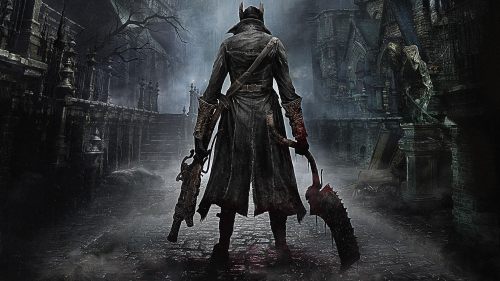DREAMS Game Review: A Breathtaking Call To Creativity
Come to Dreams looking for a new video game to play, and you'll be a little bit confused. British developer Media Molecule's astonishingly ambitious followup to 2D game-maker Little Big Planet has a wealth of user-created games on offer, and many are pretty good. Art's Dream - the two-hour game built by Dreams' developers to demonstrate its capabilities - is frequently amazing. But none of those games should be your focus when you purchase Dreams. Your focus should be on the games you want to make, and the sky very nearly is the limit.
Dreams is a fully 3D and fully-featured game-making suite the likes of which haven't really ever been seen before. What Media Molecule has accomplished is nothing short of spectacular, making complex art and design processes shockingly palatable to people with zero experience in making their own stuff. Whether setting out to make a masterpiece or just pottering about, creating in Dreams is a delight, thanks in no small part to a heart-rendingly cute and accessible UI design. The delight might be hampered by frustration at times, but it's a delight nonetheless.
The depth of tools Dreams makes available is truly staggering. When hearing about it for the first time, it’s easy to assume that it takes a training-wheels-heavy approach, offering users merely the ability to mix and match prefab objects and characters. But you really can build a game from the ground up here - from sculpting models to rigging characters and cameras to designing intricate gameplay logic and animation. The initial learning curve is shockingly easy, largely thanks to numerous slick tutorials, but the skill ceiling is extremely high. The more you discover in Dreams, the more your eyes will widen at the possibilities it offers.
That's not to say that you can't throw a game together out of prefab elements, and even the many that are offered are themselves editable down to their most minute details. The process of designing a game in Dreams typically starts by using such elements to sketch things out, then going back and remaking everything in your own image once the idea's there. You'll resculpt objects, or combine elements of multiple objects into a new one. You'll attach sensors and wires and animators to characters to make them notice things and move. You'll use the many customisation tools to finesse the look and feel of your scene, within the painterly bounds within which the game operates. It's all very freeform and freeing, and since everything in the game is driven by vectors and math, rather than raw data, everything runs pretty smoothly too.
There’s probably no better illustration of Dreams’ range of music-composition module. Having done a bunch of work as a composer on the non-BMD side of my career, I was skeptical that PlayStation software - especially a one-size-fits-all app like Dreams - could possibly offer a rich musical toolset. But not only does Dreams offer a bunch of prefab music loops and so on; it also offers a slew of virtual instruments that are performable with the controller or programmable with a piano roll editor, and which themselves can be customised and programmed in a wide variety of ways. It’s actually astounding, and I probably haven’t even scratched the surface.
Even the area of development that most terrifies me (and likely others), coding the actual mechanics of a game, is surprisingly intuitive. Once you get your head around the way it works - a pedalboard-like system of inputs and outputs, wires, filters, and so on - it's only a matter of thought to determine what you want to happen, what module you need to make that happen, and how you need to wire it up. Usually, things get more complicated than a single box, and Dreams allows for complex nesting of logic operators to make things happen. It can be messy and bewildering - it's all too easy for workspaces to become a sprawling mess of pop-up virtual microchips - but hot damn, it's satisfying when things finally start to work and potential starts to get realised.
"Potential" really is the word here. Dreams can be used to make art through sculpting and painting; to write music; to animate films with full sound design, lighting, and camerawork; and of course, to make fully-fledged video games in all manner of genres. All of this can be as clumsy or precise, as simple or as complex, as you're willing to make it. More elaborate game setups require much more thought, of course, but thanks to robust tooltips and the like, it's entirely plausible to tinker your way through the creation of one. As much as it may sound like marketing bullshit, Dreams is limited only by, to a large extent, the user’s imagination.
It's interesting to see what gamers' imaginations have produced - and what other gamers' imaginations have decided to reward with upvotes. As always, the first things anyone ever seems to create with tools like this are recreations of things that already exist. Firing up the "Dreamiverse" and perusing the creations therein, many of the top results are remakes of other games, like the ubiquitous PT, or of characters or scenarios from popular movies (and naturally, Thomas the Tank Engine). In this case, working with familiar subject material is a pretty solid way to focus on learning the tools themselves. Indeed, the first project I started working on was a remake of a short animated film I co-directed a couple of years ago. Once that’s out of people’s systems, we’ll start seeing some truly spectacular original works.
In addition to imagination, making "dreams" takes time and effort, and that’ll be a pretty hard ceiling for a lot of people - myself included, probably. Despite its accessibility, learning and working in Dreams isn't an instantaneous process. A sizeable project will take hundreds of hours to complete, and though making something of your own is more deeply rewarding than playing someone else's game, it also requires more focus. These days, a lot of people don’t have time or energy for huge hobby projects. As a freelancer, I definitely fall into that category. It's hard not to feel a little bit guilty pottering about on a game when you could be out there earning a crust.
To help solve that issue, Media Molecule has put extensive work into gamifying the process of creation itself. Dreams tracks everything you do, whether it’s spraying finishes onto models, creating force emitters, or putting together logic calculators, and duly offers congratulations upon having achieved arbitrary levels in each activity. An optional quest system prods you into trying out new ideas. The community features help, too: in addition to upvoting and commenting, there’s a robust attribution system for charting which creations begat which. There’s a common understanding that everything released publicly in Dreams can be remixed by someone else, and it’s always fun to chart how basic objects have found their way into much larger creations.
Unsurprisingly, the greatest barrier to achieving the best results is the PlayStation controller. Though Dreams uses nearly every feature of the DualShock 4 in a more or less intuitive and consistent fashion, the controller just isn’t precise enough to make rapid and fine adjustments in 3D space. By default, the controller’s gyroscope is the mechanism that drives the game’s cursor, and even with the steadiest hands and the optional grid-snap feature, you’re going to make constant mistakes. The controls are probably as good as they could be for PlayStation software, but Dreams cries out for a PC port - or better yet, a VR port, to help allay the depth-perception issues that frequently make sculpting and painting a nightmare.
But then, for all its wild possibilities, Dreams isn't for those designers who want to create precision work, so much as it's for people who want to sketch and play and experiment. The sculpting tools are based around 3D brushes, not polygon editors; around slapping down clay, not adjusting topology directly. The same goes for the music tools, which push performance towards jazzy improv, and the animation tools, which favour handmade motion or simple keyframes. You can use these tools to create precise results, but the ideal way of working is rough and fun. Get too caught up in the details, and you'll go mad.
Moving forward, we're bound to see genuinely release-worthy work come out of Dreams' userbase. It's already starting to happen, even within the confines of its community-jam events. The biggest issue, though, might be discovery: even with a degree of curation, you get the sense that many great or unique works are being buried under the morass of clones and joke projects. The good shit is out there, though. It's just a matter of finding it. Or, failing that, making it your damn self.



